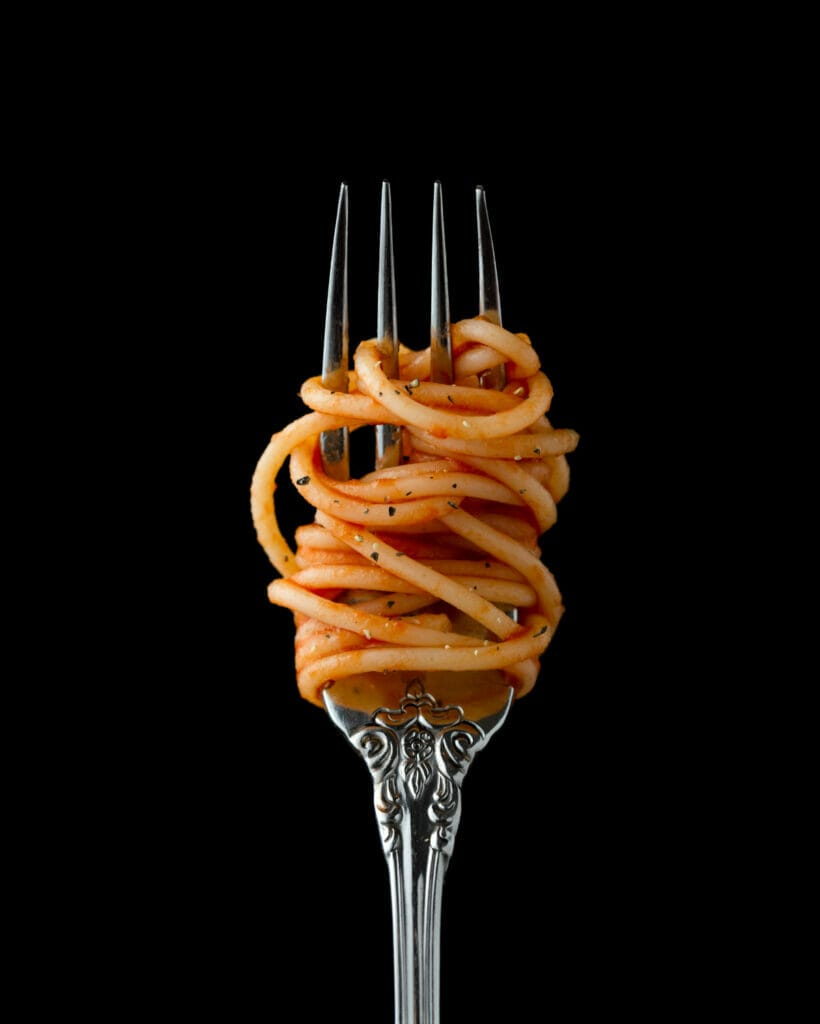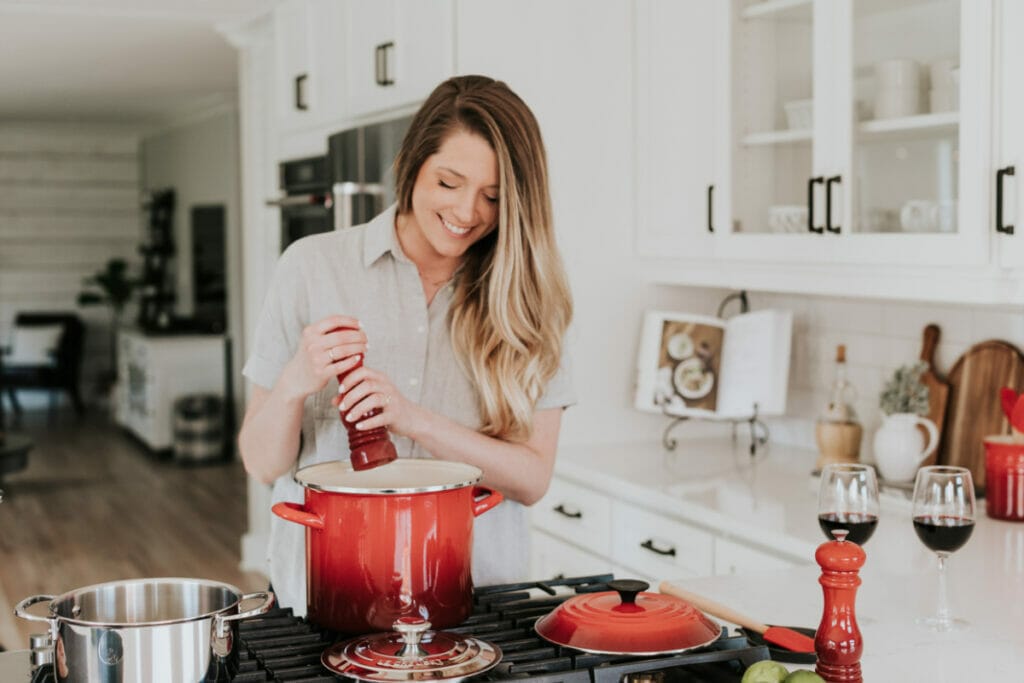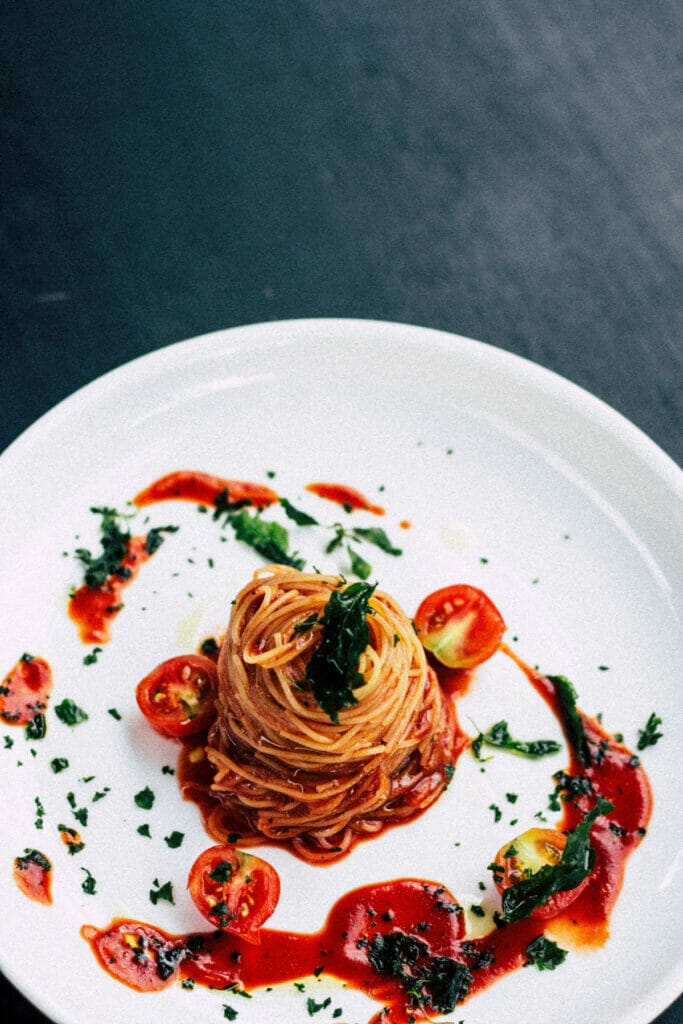As an Amazon Associate, I earn from qualifying purchases. In addition, I participate in several other affiliate programs that allow me to earn while I recommend products I love.
Want to know how to keep pasta from sticking together?
Pasta is such a popular dish, but many people find that they end up with a clump of noodles rather than the deliciously smooth and individual strands of spaghetti that makes life worth living.
If you can dig your fork into the pot of cooked pasta and all of the pasta comes up together, you’ve got a problem.
Luckily, it’s super easy to keep spaghetti noodles from sticking together (this also applies to other types of pasta, though spaghetti presents the biggest challenge).

Our Favorite Quirky Kitchen Gadgets
- Select-A-Spice Auto-Measure Carousel – Get your exact spice amount without measuring spoons with this spice carousel. Simply twist the dial for a perfect 1/4 teaspoon measurement!
- Silicone Utensil Rest with Drip Pad – This utensil rest keeps my countertops neat & drip-free!
- Snap N Strain Pot Strainer and Pasta Strainer – I love this strainer because it fits on all pots and pans while also being compact and easy to use!
- Herb Scissors Set – I use these scissors to cut and mince fresh herbs directly into any dish without the tedious work of cutting each herb or dirtying up a cutting board.
- Knife Sharpener – I love how quirky and nifty this rhino shaped knife sharpener is. It definitely puts the FUN in functional!
How to Stop Spaghetti from Sticking during Cooking
We all know how to cook spaghetti (and if you don’t, check out our guide on how long to cook dry pasta and how long to cook fresh pasta).
You boil some water in a pot, and then throw the spaghetti noodles in!
It’s a recipe as old as time and one of the first things most people learn to cook, but there are some extra steps you should take instead of just walking away to make sure that your noodles don’t clump.

1. Stir Frequently
There is nothing better to stop pasta from sticking together than stirring frequently.
When you put the pasta in, you should use a plastic or wooden spoon (metal ones can scrap your pot) and physically move all of the noodles around and separate them as much as possible.
This is particularly important with longer strands of things like spaghetti, linguine, and angel hair pasta.
If you leave it to its own devices with no stirring, you may find that they actually fuse together and cook as opposed to cooking as individually strands.

Stirring is most important in the first half of the boiling process.
Stir for a good 30 seconds or so when you first get the noodles in the water (when they have softened up enough to actually be under the water), and then stir every minute or so until you can tell that the noodles have taken on water and are nearing their final shape and texture.

2. Make Sure You Have Enough Water
Let’s say that you’re stirring and you still find your pasta is sticking together.
You may have gone wrong with your pasta to water ratios.
My golden rule of thumb when it comes to cooking pasta is that too much water is better than too little.
The pasta will expand in the pot as it cooks, and it will release starches into the water.
If there’s not enough water in the pot, the noodles itself and the starches will have nowhere to go and you may end up with a sticky pot of pasta.

Typically following the instructions on the pasta box is just fine, but if you’re unsure, always size up or add another cup of water.
I like to leave a solid 2 inches of water above my pasta, at least.
If you pour in your dried pasta and some is sticking out of the top of the water or it’s just beneath the surface, you’re going to be in for a bad time when the cooking process begins because it’s already bulging out.

This also goes for if you’ve microwaving your spaghetti (yes, that’s a thing). Make sure you’ve added plenty of water to cover all of those noodles.
3. Do Not Add Oil
Some people say to add oil to your pasta water to prevent it from sticking together.
Do not do this!
Adding oil into your water is not going to help.
Why?
Have you ever heard “oil and water don’t mix”?
Well, they don’t.
Literally.

It’s going to be hard for the oil to coat the noodles in the first place because it will just float around in your water, not mixing with the water or the pasta.
Even the parts of it that do are going to cause you problems if you want to eat the noodles with sauce later.
Many sauces are water-based, and when you go to pour sauce on spaghetti that has been cooked in water with oil, you’ll find that the sauce slides right off.
Leave the oil for after cooking (with major caveats, keep reading).

4. Add Salt to the Water
Salt on its own is not necessarily going to keep your pasta from sticking, but it is an essential part of cooking pasta for the flavor.
The jury is out on whether salted boiling water will help keep the noodles apart more than regular boiling water, but all chefs recommend a large amount of salt in your pasta water so it can’t hurt to try.

How to Keep Cooked Pasta from Sticking
So you’ve already made your pasta and it seemed okay while boiling, but now you’ve got a starchy, clumpy mess.
Here’s how to keep pasta from sticking after cooking because the tips differ from what you would do while it’s boiling.

5. Rinse in Fresh Boiling Water
When you finish cooking pasta, it’s going to be covered in starchy water that it has just cooked in.
This starch will start to firm up between the noodles and create clumps if it’s not dealt with.
This is most important if you’re eating the noodles without sauce or with something like butter or oil.
If you are eating it with sauce, the sauce likes the starchiness to bind to so you can skip this step.
Either boil a fresh kettle of water or turn your faucet on to the hottest water you can manage, and rinse the drained pasta noodles in hot water.
This will help them keep their temperature for eating soon, while getting rid of the extra starch that will make the noodles stick together.

6. Rinse in Cold Water
If you’re making something like a pasta salad that is meant to be eaten cold or you are just going to save the pasta for later and will need to reheat it, you can go ahead and rinse in cold water.
Cold water stops the cooking process, which is convenient, and will keep your noodles perfectly separate.
But if you’re about to eat the pasta, don’t douse it in cold water!
Use the boiling water tip from above.

7. Add Oil
Earlier, we said not to add oil to the pasta water as it won’t help prevent it from sticking enough to make it worth all of the other problems it can cause.
But what about cooked pasta?
You can add oil to cooked spaghetti to keep it from sticking, and it will do a good job, but you have to make sure you’re not planning on adding a sauce to it.
Some people like noodles plain, or with a bit of oil and garlic and butter, and in this case, go ahead and put oil on it.
However, oil will prevent sauces from sticking to the noodles, so do not do this if the noodles are destined to be paired with a sauce.
8. Add Butter
Everyone loves butter on their pasta noodles, and from past experience, we can say that adding butter to pasta noodles does help prevent the cooked noodles from sticking together.
If you’re adding a sauce, put the butter in the sauce and skip this step to make sure it all mixes together well.
But if you just want some plain noodles with butter, then go ahead and add butter after it’s cooked.

How to Keep Fresh Pasta from Sticking Together after Cooking
Let’s talk about fresh pasta!
All of the above tips were about how to make sure dried pasta doesn’t stick together.
But what if you’re a regular old Gordon Ramsey and you’ve made your own fresh pasta!
Fresh pasta can actually be even harder to keep from sticking together because of the doughy nature of it, so you’re going to want to follow all of the same steps above plus this top tip.
9. Coat in Flour
To keep fresh pasta from sticking together, coat it in rice, corn, or seminola flour before boiling.

Do not coat it in more regular flour.
Make sure to use one of the flours mentioned.
These flours will help keep the noodles from sticking together as the pasta cooks without adding to your clumpiness (the word “clumpy” has now lost all meaning after this article!)
